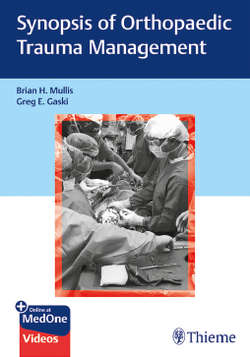Читать книгу Synopsis of Orthopaedic Trauma Management - Brian H. Mullis - Страница 13
I. Fracture Healing Components
ОглавлениеA. Bone blood supply and the effects of fracture and reaming
1. Endosteal blood flow from high-pressure system nutrient arteries creates a centrifugal (inside to out) pattern of blood flow.
2. Periosteal blood flow from low-pressure system supplies the outer ~one-third of bone cortex.
3. Fracture disrupts blood flow causing acute hematoma to develop at the injury site.
4. Reaming damages the endosteal blood supply and temporarily changes the blood flow pattern to centripetal (outside to in).
B. Cells
1. Mesenchymal stem cells (MSCs)—precursors to blood vessels, muscle, fat, cartilage, and bone. Differentiate down different pathways depending on the mechanical and biologic signals received (▶Fig. 1.1). Can come from remote or local cell populations. In bone, local populations are periosteal, endosteal, muscle, blood vessels, and bone marrow.
2. Chondrocytes—derived from MSCs and form cartilage intermediate during endochondral bone formation.
3. Osteoblasts—derived from MSCs or via transdifferentiation of hypertrophic chondrocytes. Produce collagens and other proteins (e.g., osteocalcin, osteopontin) to form extracellular matrix (ECM) and also secrete regulatory proteins (e.g., osteoprotegerin [OPG], receptor activator of nuclear factor kappa-B [RANK] ligand, bone morphogenetic proteins [BMPs]) that affect fracture healing processes. They have parathyroid and vitamin D receptors and are responsible for matrix production during intramembranous and endochondral bone formation.
4. Osteocytes—fully differentiated osteoblasts that exist in mature bone matrix. They respond to parathyroid hormone (PTH) or mechanical loading and secrete sclerostin to help regulate osteoblastic bone formation or osteoclastic bone resorption.
5. Osteoclasts—derived from monocytes/macrophages, not from MSCs. These cells are responsible for bone resorption during intramembranous bone formation and remodeling. These attach to bone surfaces via integrin receptor signaling. Once attached, a ruffled border is created forming a local acidic environment to dissolve hydroxyapatite. Osteoclasts have the RANK receptor. PTH stimulates bone resorption by increasing osteoclast activity indirectly via osteoblast production of RANK ligand (RANKL).
C. Extracellular matrix (ECM)
1. Organic component of ECM consists of different collagens and other stored proteins responsible for cell adhesion and signaling. The collagen expressed varies throughout the different stages of secondary fracture healing. The organic component of mature bone tissue is known as osteoid.
2. Inorganic component is predominantly hydroxyapatite (Ca5(PO4)3OH). Mineralization of osteoid results in mature bone tissue.
D. Cytokines (proteins that modulate immune response and cellular communication), growth factors (proteins that affect cell differentiation, proliferation, and function), and transcription factors (intracellular DNA-binding proteins that modulate gene transcription): There is a myriad of these. Their function depends on location and time of expression during fracture healing.
Fig. 1.1 Factors involved in differentiation of mesenchymal stem cells (MSCs). Depending on the signals received, MSCs can differentiate into blood vessels, bone, cartilage, muscle, or fat. Arrows are positive signals promoting differentiation into that cell type. T’s are negative signals preventing differentiation into that cell type. BMP-2, bone morphogenetic protein 2; C/EBP, CCAAT-enhancer-binding proteins; EGF, epidermal growth factor; FGF-2, fibroblast growth factor 2; LRP5/6, low-density lipoprotein receptor-related protein 5/6; MEF2, myocyte enhancer factor-2; MRF, muscle regulatory factors; Osx, osterix; PDGF, platelet-derived growth factor; PPAR, peroxisome proliferator-activated receptor; TGF-β transforming growth factor beta; VEGF, vascular endothelial growth factor.
1. Proinflammatory cytokines (e.g., tumor necrosis factor alpha [TNF-α], interleukin-1 [IL-1], IL-6)—recruit inflammatory cells, promote angiogenesis, modulate osteoblast/osteoclast differentiation, and affect cellular gene expression.
2. Transforming growth factor beta (TGF-β) superfamily, including BMPs—carry out MSC recruitment and differentiation into chondrocytes or osteoblasts and cellular proliferation. These proteins are stored in bone ECM in latent form.
3. Vascular endothelial growth factor (VEGF), angiopoietins—vascular ingrowth, neoangiogenesis, and revascularization of callus.
4. Wnt/β-catenin—canonical Wnt pathway regulates the amount of β-catenin transcription factor present intracellularly, guides differentiation of MSCs into osteoblasts, and regulates osteoblast activity during bone formation. Wnt signaling also inhibits osteoclastogenesis by increasing osteoblast synthesis of OPG.
5. Sclerostin—secreted by osteocytes and inhibits Wnt signaling.
6. OPG/RANKL—OPG is a decoy receptor for RANKL. RANKL produced by osteoblasts stimulates osteoclastogenesis. Their balance leads to resorption of mineralized cartilage and formation of woven bone.
E. Metabolic/endocrine components
1. Calcium.
2. Vitamin D—necessary for bone mineralization.
3. Vitamin C—necessary for collagen production.
4. PTH—important homeostatic regulator of serum calcium level and vitamin D metabolism by actions on bone, kidneys, and intestine. It also regulates endochondral bone formation. In recombinant form (Forteo®) it used to increase bone mass. It has also been used in treatment of nonunions, though clinical evidence of efficacy for this indication remains to be proven.
